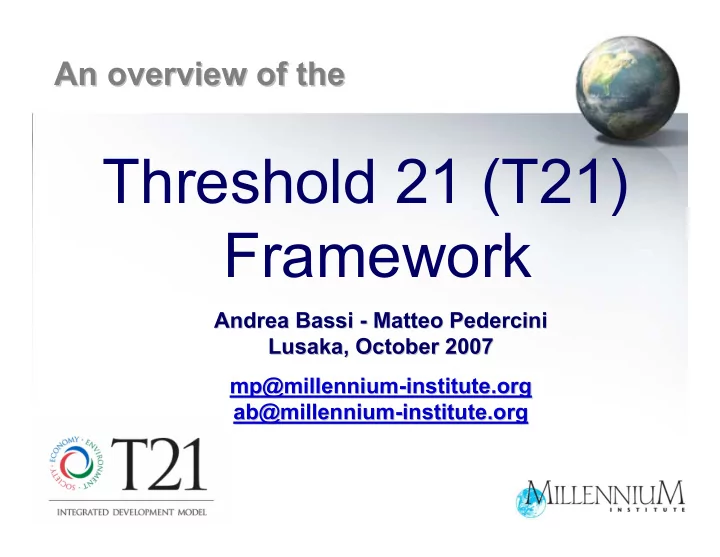

An overview of the An overview of the Threshold 21 (T21) Framework Andrea Bassi - - Matteo Pedercini Matteo Pedercini Andrea Bassi Lusaka, October 2007 Lusaka, October 2007 mp@millennium- -institute.org institute.org mp@millennium ab@millennium- -institute.org institute.org ab@millennium
Summary Summary 1. Background: the Millennium Institute (MI) 2. T21: History 3. T21: the Starting Framework 4. Conclusions
Millennium Institute – – Mission Mission Millennium Institute Help people and organizations enhance insight for decision-making in complex systems towards the development of a global sense of shared responsibility about our common future . •Developing and disseminating advanced analytical tools that support prospective strategic planning •Increasing capacity among a broad range of partners in System Dynamics and Threshold 21 around the world
History of T21 History of T21 The origins: 1980 - - 1994 1994 The origins: 1980 1980: Dr. Gerald O. Barney directs the Global 2000 Report for President Carter 1983: Millennium Institute is founded 1983-1993: Research on national planning models (Managing a Nation) 1994: First application of T21 (Bangladesh)
History of T21 History of T21 Recent evolution: 1995 - - 2007 2007 Recent evolution: 1995 • Applications in over 25 countries T21 Bangladesh T21 Tunisia T21 Malawi T21 Italy T21 Cambodia T21 Somaliland T21 Guyana T21 China T21 Papua T21 Thailand T21 USA T21 Bhutan T21 Ghana T21 Mali T21 Mozambique T21 Cape Verde T21 Santa Lucia T21 AEO T21 Balkans T21 Jamaica • Trained hundreds of people • Broadening of basic structure • Continuous update of key relationships • Development of user interface
History of T21 History of T21 Recent evolution: 2005 - - 2007 2007 Recent evolution: 2005 • Series of external reviews: � Jack Homer (MIT) � University of Bergen � UNDP • Open source – non commercial purposes • Models’ library for download
History of T21 History of T21 T21 applications worldwide T21 applications worldwide Back
T21 Implementation T21 Implementation Implementation process outline Implementation process outline 1. Identification of key issues to be analyzed 2. Data collection and analysis 3. Training Phase I – min. 6 weeks 4. Development of T21-Country first version 5. In-depth analysis and discussion of results 6. Training Phase II – min. 2 weeks 7. Modification of the model => final version 8. Analytical report, documentation and user version Time required: Min. 6 months
T21 Overview T21 Overview What is T21 for? What is T21 for? The model was originally built for serving three purposes: (1)Studying mid-long term development issues (2)Testing alternative policies (3)Enhancing learning about system => Support mid-long term planning through understanding of the system
T21 Overview T21 Overview Necessary characteristics Necessary characteristics Necessary characteristics for mid-long term planning models: 1. Endogenously represent key variables (E) 2. Comprehensive (C) 3. Properly represent dynamic complexity (D) 4. Transparent (T)
T21 Overview T21 Overview Exogenous vs. Endogenous GDP Exogenous vs. Endogenous GDP Gov. Gov. GDP Revenue Expenditure Society Economy Environment
Overview of Approaches Overview of Approaches Commonly used approaches Commonly used approaches Approach Software E C D T Accounting spreadsheets MS-EXCEL NO NO NO YES Macro-econometrics EVIEWS YES NO YES NO Computable general eq. GAMS YES NO YES NO System dynamics VENSIM YES YES YES YES
T21 Overview T21 Overview System Dynamics approach System Dynamics approach Strengths of System Dynamics - Vensim approach: 1. Proper representation of complexity 2. Multidisciplinary 3. Transparent – User friendly 4. Flexible 5. Powerful
T21 Overview T21 Overview Time Horizon of Analysis Time Horizon of Analysis 2030 National Vision National Development Plan 2015 MDG Strategies 2011 Mid Term Strategic Plans 2008 Yearly Budgets
T21 Overview T21 Overview Type of issues at stake Type of issues at stake Some examples of issues T21 can address: • Poverty • Economic and demographic growth • Access to social services – Education – Healthcare • Environmental sustainability • Energy transitions • …
T21 Overview T21 Overview Type of model Type of model • System Dynamics model • Dynamic • Model is solved via simulation • Uses sensitivity analysis (Kalman filetering) • Uses optimization techniques (Montecarlo) • Represents causal relationships • Structural approach
T21 Architecture T21 Architecture Population Births Population Technology Deaths Health Government Households Labor Society Economy Revenue Infrastr Education Investment ROW Expenditure ucture Financing Poverty Production Debt Primary Agriculture Education Industry Secondary Land Education Services Energy Water Environment Energy Water Demand Demand Minerals Emissions Energy Water Supply Sustain Supply ability
T21 architecture T21 architecture row education government infrastruc ture poverty investment health households production labor technology population energy water minerals land sustainabi lity emissions
Advantages and Limitations Advantages and Limitations Advantages of T21 approach Advantages of T21 approach 1. Captures overall socio-economic- environmental developments 2. Proper representation of dynamic complexity: Feedbacks and Delays 3. Multidisciplinary 4. Transparent – User friendly 5. Flexible 6. Powerful engine - Vensim
Advantages and Limitations Advantages and Limitations Limitations of T21 approach Limitations of T21 approach • Mid-long term approach: misses short-term dynamics • National/Global perspective: does not consider local diversity • Medium-High level of aggregation: parameters are averaged by sector • Requires active involvement of client in definition of model’s structure
T21 Examples T21 Examples T21 Applications: examples T21 Applications: examples � Mali: PRSP II & MDG analysis � Malawi: Vision 2020 and Policy Framework Paper (PFP) � Mozambique: Agenda 2025 � Jamaica: Development Plan � Ghana: MDG Analysis
Millennium Institute Millennium Institute Activities Activities � Develop T21-Starting Framework (SF): Open Source, for non-commercial purposes � MCM customization � T21-SF customization � On site custom training (2 weeks) � 6-week training � 2-day Development exec. course
Millennium Institute Millennium Institute Vision for the future Vision for the future � Internationalization and decentralization � Emphasis on MDG and national priorities � Emphasis on Africa (& developing nations) � Capacity building for long term (Universities) � New partnerships (public & private) - UNU
Thank you for your attention Thank you for your attention Questions and comments Questions and comments are welcome are welcome www.millennium-institute.org mp@millennium-institute.org ab@millennium-institute.org
Recommend
More recommend